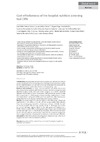Identificador persistente para citar o vincular este elemento:
https://accedacris.ulpgc.es/jspui/handle/10553/71255
| Título: | Cost-effectiveness of the hospital nutrition screening tool CIPA | Autores/as: | Suárez-Llanos, José Pablo Vallejo Torres, Laura García-Bello, Miguel Ángel Hernández-Carballo, Carolina Calderón-Ledezma, Eduardo Mauricio Rosat-Rodrigo, Adriá Delgado-Brito, Irina Pereyra-García-Castro, Francisca Benitez-Brito, Nestor Felipe-Pérez, Nieves Ramallo-Fariña, Yolanda Romero-Pérez, Juan Carlos |
Clasificación UNESCO: | 32 Ciencias médicas | Palabras clave: | Cost-Benefit Analysis Inpatients Malnutrition Nutrition Assessment Quality Of Life |
Fecha de publicación: | 2020 | Publicación seriada: | Archives Of Medical Science | Resumen: | Introduction: Hospital malnutrition is very common and worsens the clinical course of patients while increasing costs. Lacking clinical-economic studies on the implementation of nutrition screening encouraged the evaluation of the CIPA (Control of Food Intake, Protein, Anthropometry) tool. Material and methods: An open, non-randomized, controlled clinical trial was conducted on patients admitted to internal medicine and general and digestive surgery wards, who were either assigned to a control (standard hospital clinical care) or to an intervention, CIPA-performing ward (412 and 411, respectively; n = 823). Length of stay, mortality, readmission, in-hospital complications, and quality of life were evaluated. Cost-effectiveness was analysed in terms of cost per quality-adjusted life years (QALYs). Results: The mean length of stay was higher in the CIPA group, though not significantly (+ 0.95 days; p = 0.230). On the surgical ward, more patients from the control group moved to critical care units (p = 0.014); the other clinical variables did not vary. Quality of life at discharge was similar (p = 0.53), although slightly higher in the CIPA group at 3 months (p = 0.089). Patients under CIPA screening had a higher mean cost of € 691.6 and a mean QALY gain over a 3-month period of 0.0042. While the cost per QALY for the internal medicine patients was € 642 282, the results for surgical patients suggest that the screening tool is both less costly and more effective. Conclusions: The CIPA nutrition screening tool is likely to be cost-effective in surgical but not in internal medicine patients. | URI: | https://accedacris.ulpgc.es/handle/10553/71255 | ISSN: | 1896-9151 | DOI: | 10.5114/aoms.2018.81128 | Fuente: | Archives Of Medical Science[ISSN 1734-1922],v. 16 (2), p. 273-281, (Febrero 2020) |
| Colección: | Artículos |
Citas SCOPUSTM
4
actualizado el 08-jun-2025
Citas de WEB OF SCIENCETM
Citations
4
actualizado el 08-jun-2025
Visitas
220
actualizado el 31-may-2025
Descargas
138
actualizado el 31-may-2025
Google ScholarTM
Verifica
Altmetric
Comparte
Exporta metadatos
Los elementos en ULPGC accedaCRIS están protegidos por derechos de autor con todos los derechos reservados, a menos que se indique lo contrario.
